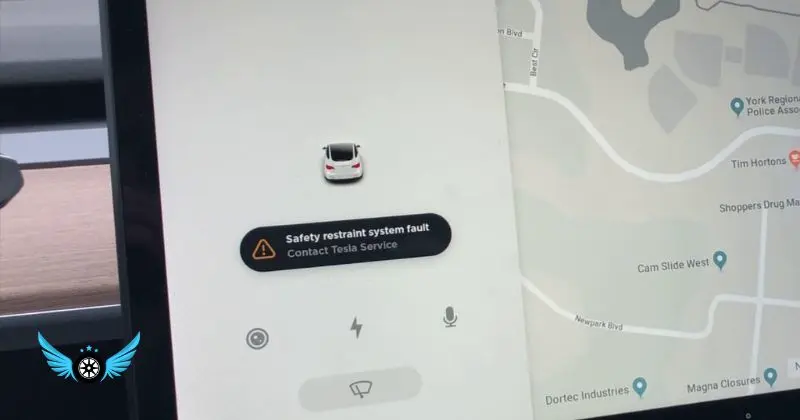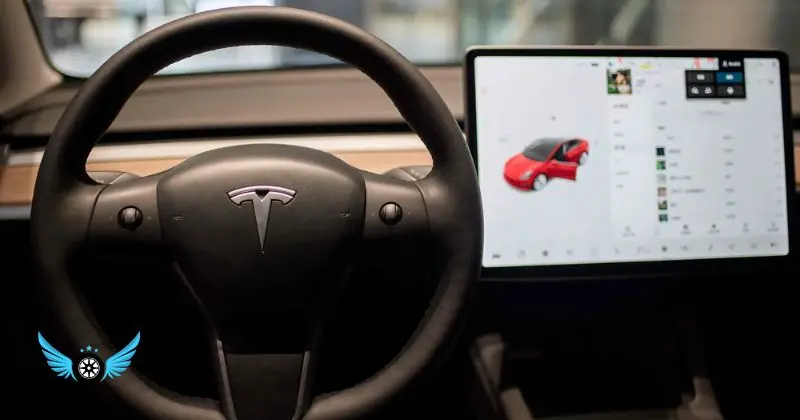Have you ever encountered a Tesla front passenger safety restraint system fault? An annoying problem can make you question your car’s safety.
In this post, we will look at what causes this problem and how to fix it. For more information on how to ensure your Tesla’s safety systems are working correctly, keep reading with Teslasuggest
What is The Meaning of Tesla Front Passenger Safety Restraint System Fault?

You may see a notification on your car’s dashboard that reads “Tesla front passenger safety restraint system fault” if you own a Tesla. This problem suggests that your Tesla’s safety restraint system, a vital element in ensuring passengers’ safety in crashes, is malfunctioning. You can diagnose the issue and take the appropriate action to fix it by being aware of the many faults that might affect safety restraint systems.
Types of Tesla Front Passenger Safety Restraint System Faults
Your Tesla may experience the following typical problems, which might result in a notice about Tesla front passenger safety restraint system fault:
Faulty seatbelts: The seatbelt system in your Tesla might develop issues with its sensors or mechanical parts. These problems may make it difficult for the seatbelt to fasten securely during a collision, endangering the front passenger’s safety.
Airbag problems: Another essential part of the safety restraint system in your Tesla is the front passenger airbag. Two examples of airbag-related faults are sensor difficulties and troubles with the airbag’s deployment mechanism.
It’s critical to solve any problems with your Tesla’s safety restraint system as soon as possible. Consult the Teslasuggest for advice from other Tesla owners who may have encountered related difficulties or ask for help from Tesla’s service staff.
Remember, maintaining the correct operation of your Tesla’s safety restraint system is essential for preserving both the general performance and dependability of your car as well as the safety of your passengers.
Causes of Tesla Safety Restraint System Faults

Sensor Problems
Sensor problems are one of the main reasons for the safety restraint system failure in your Tesla. Both the presence of a person in the seat and the presence of a seatbelt are detected by these sensors. A sensor loses its ability to accurately identify the passenger or seatbelt when it is misaligned or broken. Your car will therefore show a fault alert. Make sure the sensors are in their proper locations and are clean in order to solve this problem.
Wiring Issues
Safety restraint system fault alarms may also be brought on by faulty wiring or broken connections under the passenger seat. Crushed, squeezed, or disconnected wires are only a few examples of such problems. The connections under the passenger seat should be thoroughly inspected for any evidence of damage or disconnection. Consult a service center for appropriate repair if you discover a problem.
Mistakes with Seatbelts and Airbags
Another reason for Tesla front passenger safety restraint system fault notifications is an issue with the airbag or seatbelt. Your safety depends on the airbags and seatbelts operating properly. The safety restraint system is connected to these parts as well. A system problem may be brought on by any issues with the airbag or seatbelt systems. To identify and fix the problem in such circumstances, it is essential to get in touch with a Tesla service facility.
How to Detect Tesla Front Passenger Safety Restraint System Fault
Warning Messages
The dashboard warning signals in your Tesla’s safety restraint system might be a good indicator of problems with the system. The error message “Front Passenger Safety Restraint System Fault” may show up on the screen if you have a problem.
Don’t be alarmed; these messages are intended to inform you of potential problems with the safety features of your car. They can point to a problem with the seatbelt sensor or a disconnected system part. To keep your car safe for you and your passengers, be careful to respond to these warning signals as quickly as you can.
Diagnostic Equipment
Using diagnostic tools is another way to find Tesla front passenger safety restraint system fault. These instruments are made to read and decipher the error codes generated by the onboard computer system in your car.
You may get the error codes and learn more about the possible malfunction by attaching the diagnostic kit to the OBD-II port. This can aid you in identifying the precise problem and determining whether you can do the repair yourself or if your Tesla requires the services of a qualified mechanic.
Fixing The Tesla Front Passenger Safety Restraint System Fault

Fault Code Reset
- Resetting the system may be able to resolve an issue that occasionally causes the fault notice to appear. For this, you may:
- Turn off your Tesla and give it some time to cool.
Check to see whether the problem notice has vanished after restarting the vehicle.
If it doesn’t work, you might attempt a hard reset by doing the following:
- Turn off the Tesla.
- For around 20 seconds, press and hold both scroll buttons on the steering wheel.
- Wait for the Tesla logo to display on the screen before releasing the buttons.
- Check to see whether the problem notice is still there after starting your Tesla.
- Consider maintenance and repairs if the fault code continues to appear.
Maintenance
The Tesla front passenger safety restraint system issue may be avoided with routine maintenance. Be careful to follow the suggested maintenance schedule for your car, which should include:
- Examining seatbelts and airbags on a regular basis for signs of wear, tear, or damage.
- Confirming that the restraint system’s sensors and connections are all clean and operating correctly.
- Make sure the airbags and seatbelt pre-tensioners are functional.
Repairs
After resetting and inspecting your Tesla’s upkeep, you could require repairs if the fault code still appears. Sensor failure or airbag damage are two typical reasons for the front passenger safety restraint system issue. You should contact a Tesla service facility in these circumstances for an accurate diagnosis and skilled repair.
The price of repairs might vary depending on the problem. For instance, replacing a seat or airbag may cost up to $2,000 in total. Repairing smaller parts could be less expensive. The repairs can be free of charge if your car is still covered by its warranty.
Remember that your safety and the safety of your passengers depend on fixing any faults with the Tesla front passenger safety restraint system. If you require help, don’t be afraid to contact a Tesla service facility.
Conclusion
Tesla front passenger safety restraint system fault often occurs to Tesla vehicle users. It can start from many causes and there are many effective ways to fix it. The solutions in this article can help you solve this problem promptly to ensure your safety and prevent bigger problems with your vehicle.
